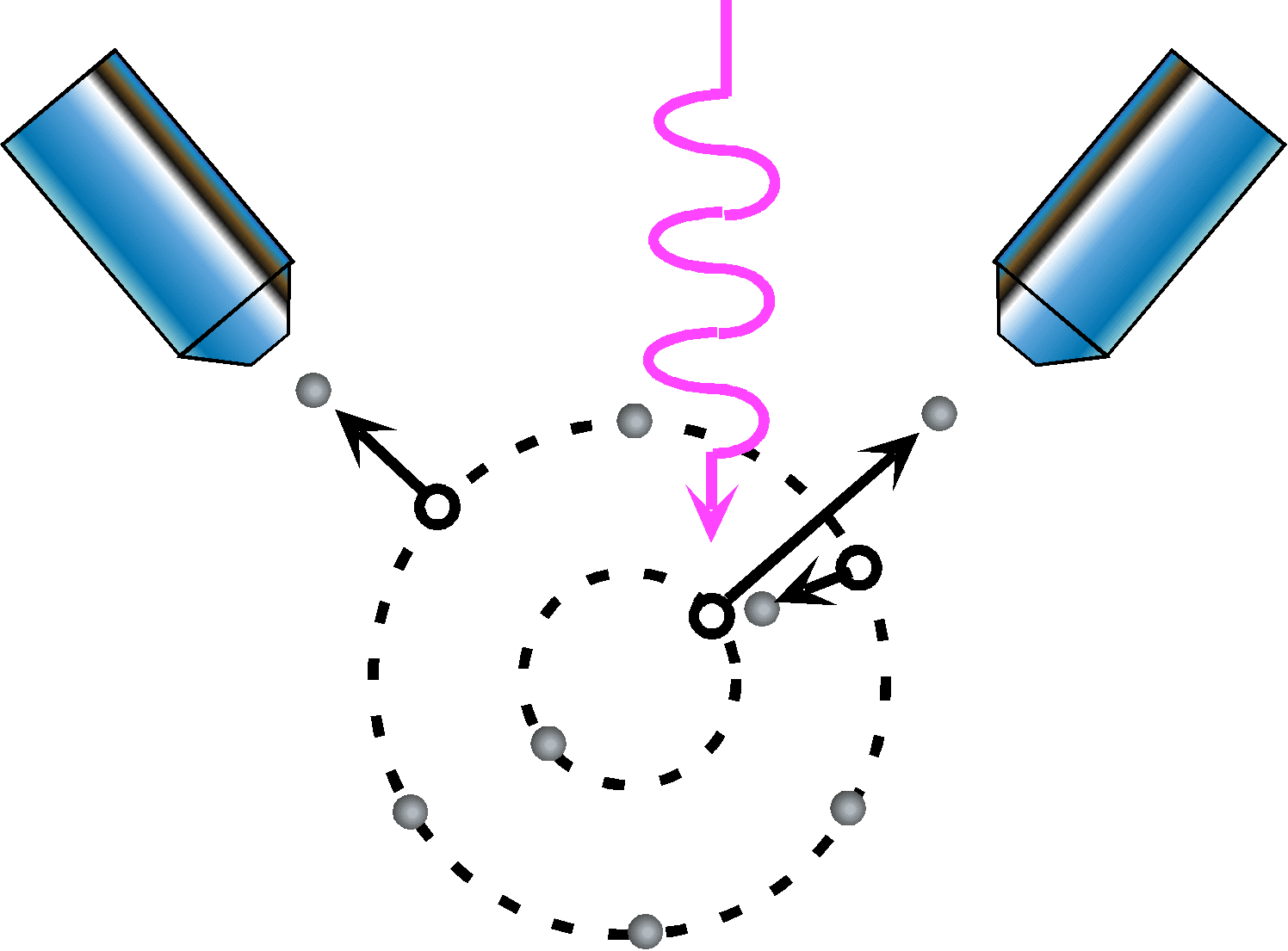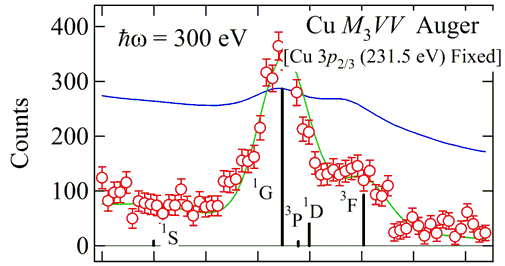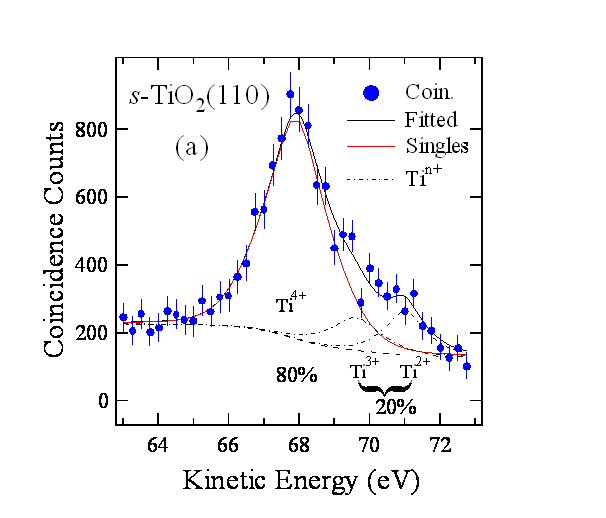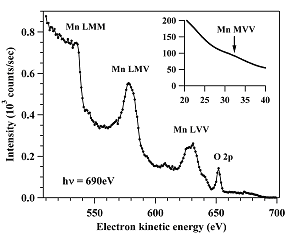|

DEPARTMENT OF PHYSICS AND
ASTRONOMY
LINKS
|

Basics: Auger Photoelectron Coincidence Spectroscopy
 Auger-photoelectron
coincidence spectroscopy (APECS) is a novel experimental technique
that enables one to examine the photoelectron distribution from a
solid with unprecedented discrimination. As the name suggests, in
APECS a core photoelectron and its associated Auger electron are
measured in time coincidence. As a result, in true coincidence
events both electrons originate from the same photoexcitation event.
Therefore, APECS is a highly incisive probe of local electronic
structure and photoexcitation/ processes in complex solids. Auger-photoelectron
coincidence spectroscopy (APECS) is a novel experimental technique
that enables one to examine the photoelectron distribution from a
solid with unprecedented discrimination. As the name suggests, in
APECS a core photoelectron and its associated Auger electron are
measured in time coincidence. As a result, in true coincidence
events both electrons originate from the same photoexcitation event.
Therefore, APECS is a highly incisive probe of local electronic
structure and photoexcitation/ processes in complex solids. |
Recent Highlights: APECS
Isolate overlapping
Auger spectra:
The figure at the left shows a
conventional (singles) spectrum [blue curve] in the kinetic energy
region of the Cu M23VV Aug er
spectrum. An APECS spectrum of the same energy region obtained
in coincidence with Cu 3p3/2 photoelectrons is shown as
the red data points. Since the APECS data only includes
electrons generated by decay of Cu 3p3/2 core holes, the
the lineshape of the isolated M3VV Auger transition is
measured. The green curve is a fit to the coincidence
lineshape based on the multiplets of the d8 configuration
of the 2-hole Auger final state (contributions shown by the vertical
bars). er
spectrum. An APECS spectrum of the same energy region obtained
in coincidence with Cu 3p3/2 photoelectrons is shown as
the red data points. Since the APECS data only includes
electrons generated by decay of Cu 3p3/2 core holes, the
the lineshape of the isolated M3VV Auger transition is
measured. The green curve is a fit to the coincidence
lineshape based on the multiplets of the d8 configuration
of the 2-hole Auger final state (contributions shown by the vertical
bars).
Enhanced sensitivity
to surface defects:
Singles (red dashed curve) and
coincidence (data points with error bars) spectra of the Ti 3p core level region from the
TiO2(110) surface. The singles spectrum shows a symmetric
lineshape assoicated with Ti ions in the 4+ oxidation states.
The coincidence spectrum show extra emission in the energy range
associated with Ti3+ and Ti2+ ions, indicating
that the coincidence spectrum is about and order of magnitude more
sensitive to the presence of surface defects (primarily oxygen
vacancies) on this surface. This added sensitivity arises
because of the higher electron density on the Ti-site for Ti ions in
reduced chemical states.
with error bars) spectra of the Ti 3p core level region from the
TiO2(110) surface. The singles spectrum shows a symmetric
lineshape assoicated with Ti ions in the 4+ oxidation states.
The coincidence spectrum show extra emission in the energy range
associated with Ti3+ and Ti2+ ions, indicating
that the coincidence spectrum is about and order of magnitude more
sensitive to the presence of surface defects (primarily oxygen
vacancies) on this surface. This added sensitivity arises
because of the higher electron density on the Ti-site for Ti ions in
reduced chemical states.
Auger-Auger
coincidence spectroscopy:
Cascade Auger decays lead to a
chain of decay processes leaving
 multiple
holes in different atomic levels. By performing a coincidence
measurement where the later transition of a cascade Auger decay is
measured in coincidence with Auger electrons generated by earlier
steps in the process can enable one to study electron-electron
interactions and the effect of different hole configurations.
The spectrum at the left shows a singles photoemission spectrum
from the MnO(100) surface excited with 350 eV photons. Several
members of a cascade Auger chain which leave holes in the M3
level of Mn. A singles spectrum of the Mn MVV Auger
region is
sho multiple
holes in different atomic levels. By performing a coincidence
measurement where the later transition of a cascade Auger decay is
measured in coincidence with Auger electrons generated by earlier
steps in the process can enable one to study electron-electron
interactions and the effect of different hole configurations.
The spectrum at the left shows a singles photoemission spectrum
from the MnO(100) surface excited with 350 eV photons. Several
members of a cascade Auger chain which leave holes in the M3
level of Mn. A singles spectrum of the Mn MVV Auger
region is
sho wn
in the inset. Contributions from the last stage of the cascade
Auger decay also
contribute to the spectrum
in
the inset.
Spectra of the same Mn MVV
region obtained under different coincidence conditions are shown in
the figure
at the left. Fig. (a) is the MVV APECS spectrum taken in
coincidence with the Mn 3p core photoelectrons, and therefore the
cascade contribution is eliminated. Spectrum (b) shows an AACS
spectrum obtained in coincidence with electrons emitted in the LMV
Auger decay and spectrum (c) is obtained in coincidence with
electrons from the LMM decay. Note that the AACS spectra [(b)
and (c)] are significantly wider than the APECS spectrum (a), in
particular, the AACS emission extends to ~ 5 eV higher energy.
This additional width indicates that the multiple valence band holes
created in the cascade process participate in the final step of the
cascade decay. wn
in the inset. Contributions from the last stage of the cascade
Auger decay also
contribute to the spectrum
in
the inset.
Spectra of the same Mn MVV
region obtained under different coincidence conditions are shown in
the figure
at the left. Fig. (a) is the MVV APECS spectrum taken in
coincidence with the Mn 3p core photoelectrons, and therefore the
cascade contribution is eliminated. Spectrum (b) shows an AACS
spectrum obtained in coincidence with electrons emitted in the LMV
Auger decay and spectrum (c) is obtained in coincidence with
electrons from the LMM decay. Note that the AACS spectra [(b)
and (c)] are significantly wider than the APECS spectrum (a), in
particular, the AACS emission extends to ~ 5 eV higher energy.
This additional width indicates that the multiple valence band holes
created in the cascade process participate in the final step of the
cascade decay.
Read more:
Electronic and magnetic properties of thin films probed by Auger
photoelectron coincidence spectroscopy (APECS),
R. Gotter, F. Offi, F. DaPieve, A.
Ruocco, G. Stefani, S. Ugenti, M.I. Trioni, and R.A.
Bartynski,J. Electron Spec. and Rel. Phenom., 161, 128 (2007)
|
Recent Publications
(back to top)
-
Spin-Dependent On-Site Electron Correlations and Localization in Itinerant Ferromagnets
R. Gotter, G. Fratesi, R.A. Bartynski, F. Da Pieve, F. Offi, A. Ruocco, S. Ugenti, M.I. Trioni, G.P. Brivio, and G. Stephani, Physical Review Letters 109, 126401 (2012)
-
Evidence for the collapse of short-range magnetic order in CoO at the Neel temperature
R. Gotter, F. Offi, A. Ruocco, F. Da Pieve, R.A. Bartynski, M. Cini, and G. Stefani, EPL 94, 37008 (2011)
-
Multiplet term selectivity in Auger-photoelectron coincidence spectroscopy from solid crystals
Stefani, R. Gotter, A. Ruocco, F. Offi, F. Da Pieve, A. Verdini, A. Liscio, H. Yao, and R. A. Bartynski, Phys. Rev. B. (2009)
-
Direct evidence for dynamic broadening of the energy spectra associated with the later steps of an Auger cascade
A.H. Weiss, S.L. Hulbert, and R. A. Bartynski, Phys. Rev. Lett. 101, 127601 (2008)
-
Electronic and magnetic properties of thin films probed by Auger-photoelectron coincidence spectroscopy
R. Gotter, F. DaPieve, F. Offi, A. Ruocco, A. Verdini, H. Yao, R.A. Bartynski, and G. Stefani,
J. Elect. Spect. and Rel. Phenom. 161, 128 (2007)
-
Modeling of the energy spectra of individual steps of the L23-M2,3M2,3-M2,3VV-VVVV
cascade chain in MnO(0001)
A.H. Weiss, R. Sundaramoorthy, S.L. Hulbert and R.A. Bartynski,
J. Elect. Spect. and Rel. Phenom. 161, 160 (2007)
-
Room temperature ferromagnetism in Mn ion
implanted epitaxial ZnO films
D.H.Hill, D.A. Arena,
R.A. Bartynski, P. Wu, G. Saraf, Y. Lu, Wielunski, R. Gateau, J.
Dvorak, A. Moodenbaugh, and Y.K. Yeo, Physica Status Solidi A,
203, 3836 (2006)
-
Ferromagnetism in Fe-implanted a-plane ZnO
Films
D.P. Wu, G. Saraf, Y. Lu, D.H. Hill, D.A. Arena, R.A. Bartynski, L.
Wielunski, R. Gateau, J. Dvorak, A. Moodenbaugh, T. Siegrist, J.
A. Raley, and Yung Kee Yeo, Appl. Phys. Lett.89, 12508
(2006)
-
The relation between crystalline phase,
electronic structure, and dielectric properties in high-k gate
stacks
S.
Sayan, M. Croft, N.C. Nguyen, T. Emge, J. Ehrstein, I. Levin, J.
Suehle, R.A. Bartynski, and E. Garfunkel, AIP Conf. Proc. 788,
92 (2005)
-
Dichroic effects in Auger-photoelectron
coincidence spectroscopy of solids
R.
Gotter, F. Da Pieve. A. Ruocco, F. Offi, G. Stefani, R.A.
Bartynski, Phys. Rev. B. 72, 235409 (2005)
-
Inverse Photoemission Spectroscopy from
Al(100)
J. F. Veyan, W. Ibanez, R.A.
Bartynski, P Vargas, and P. Haberle, Phys. Rev. B. 71,
155416 (2005)
|
|